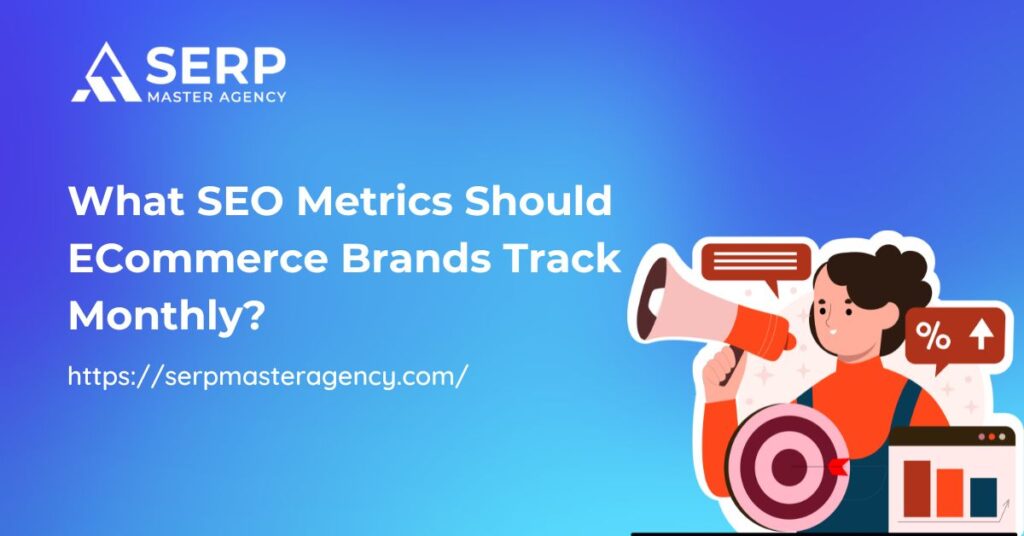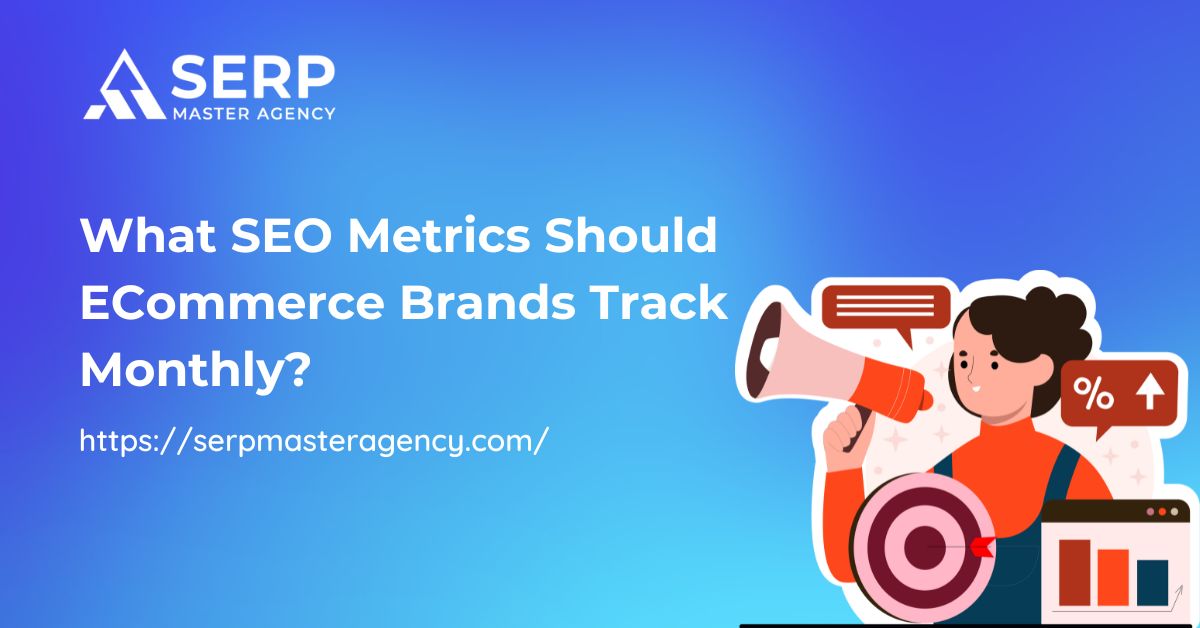Ever wonder why some online stores always seem to show up first when you search for something? It’s not just luck—it’s SEO.
For ECommerce brands, showing up in search results is one of the best ways to get more customers and increase sales. But simply doing SEO isn’t enough. You also need to track how well it’s working.
That’s where SEO metrics come in. These are the numbers that show how your online store is performing in search engines like Google.
In this article, we’ll break down the key SEO metrics ECommerce brands should check every month. When you understand what to look for, you can make smart changes that help your site grow.
Why Tracking SEO Metrics Matters for ECommerce
What Are SEO Metrics?
SEO metrics are numbers or data points that show how your website is performing in search engines.
They help you understand how people find your site, what they do once they’re on it, and how well your content and products are working.
Some common metrics include clicks, keyword rankings, impressions, and bounce rates. Many Google ranking experts use these metrics to spot problems early and guide improvements.
Think of SEO metrics like a health check-up for your website. If your numbers are off, it’s a sign something needs to be fixed.
Why Monthly Tracking Is Important
Tracking these metrics once in a while won’t tell you much. But if you check them every month, you can catch problems early, see what’s working, and adjust your strategy. This helps you plan better content, fix weak spots, and stay ahead of competitors.
Organic Traffic Growth
What It Means
Organic traffic is the number of people who visit your website after finding it through a search engine—without clicking on ads. It’s a key sign that your SEO efforts are paying off.
How to Track It
You can track organic traffic using tools like Google Analytics. Look at how many users visited your site, how long they stayed, and which pages they visited. A steady increase in organic traffic means your SEO is moving in the right direction.
Keyword Rankings
Why It’s Important
Your keyword rankings show where your site appears in search results for specific words or phrases. For ECommerce stores, these keywords usually relate to your products, categories, or topics your audience is searching for.
What to Look For
Track whether your most important keywords are moving up or down in search results. Focus on keywords that show buying intent, like “buy winter jackets online” instead of just “jackets.” These tell you if your content is showing up when people are ready to purchase.
Click-Through Rate (CTR)
What CTR Tells You
Click-through rate is the percentage of people who see your site in search results and actually click on it. If your CTR is low, people might be skipping over your listing—even if it ranks high.
How to Improve It
To improve CTR, update your meta titles and descriptions to be more appealing. For example, use product benefits, discounts, or clear calls-to-action. Your snippet should make someone want to click right away.
Bounce Rate and Dwell Time
Why These Matter
Bounce rate shows the percentage of visitors who leave your site without clicking on anything else. Dwell time measures how long a visitor stays before going back to search results.
What to Watch For
A high bounce rate might mean your page isn’t helpful or takes too long to load. Short dwell times could mean your content doesn’t match what the visitor was expecting. When people stay longer and click more, it’s a good sign your site is useful.
Conversion Rate from Organic Traffic
What It Shows
Conversion rate tells you how many visitors from search engines complete a goal, like making a purchase or signing up for a newsletter. This is one of the most important ECommerce metrics.

How to Use It
If your SEO brings in traffic but few people are buying, it could mean you’re attracting the wrong audience or your site needs changes.
Monthly conversion rate checks help you see if your content matches what shoppers are looking for.
Pages Per Session and Average Session Duration
Why It’s Useful
Pages per session tells you how many different pages a visitor looks at in one visit. Session duration shows how long they stay. Both of these reveal how engaging your site is.
What to Improve
To boost these numbers, make your site easy to navigate. Add links to related products, blog posts, or category pages.
Make sure your content is helpful and your design is clean so people want to explore more.
Mobile SEO Performance
Why Mobile Metrics Matter
Most online shoppers use mobile devices. If your website doesn’t load quickly or work properly on phones, you’ll lose potential customers.
What to Monitor
Check how much of your traffic comes from mobile, how fast your site loads on phones, and if mobile users are bouncing more often.
Google Search Console has a Mobile Usability report that highlights any issues that need fixing.
Site Speed and Core Web Vitals
The Basics
Site speed affects both your rankings and your user experience. If your pages take too long to load, visitors won’t stick around—and search engines will notice.
What to Track Monthly
Focus on Core Web Vitals:
- LCP (Largest Contentful Paint): how quickly the main part of your page loads.
- FID (First Input Delay): how soon users can interact with your site.
- CLS (Cumulative Layout Shift): how much the layout moves around while loading.
Fixing these issues helps your site perform better and rank higher.
Backlinks and Referring Domains
Why They Matter
Backlinks are links from other websites to your own. They work like votes that tell search engines your site is trusted and useful. The more high-quality backlinks you have, the more authority your site gains.
What to Check
Track the number of new backlinks and where they’re coming from. Focus on links from websites with good reputations, like news outlets or respected blogs. A good SEO Company can help you build backlinks naturally over time.
Indexed Pages and Crawl Errors
Why It’s Important
If a page isn’t indexed, it won’t show up in Google’s search results. Crawl errors happen when search engines can’t read your site properly.
Tools to Use
Use Google Search Console to check how many of your pages are indexed and if any have crawl issues. Fixing broken pages or errors keeps your site visible and running smoothly.
Top Exit Pages
What Exit Pages Tell You
An exit page is the last page a visitor views before leaving your site. Looking at these helps you understand where people lose interest.
How to Use This Data
If one product page has a high exit rate, it might need better product descriptions, images, or reviews. Try adding related product links or stronger calls to action to keep people browsing.
ECommerce SEO Metrics to Combine for Insight
Use Metrics Together
One metric alone won’t tell the full story. For example, if traffic is high but conversions are low, that could mean the wrong people are visiting your site.
If keyword rankings are strong but CTR is weak, your titles might need work.
Looking at multiple metrics together gives you a clearer picture of what’s going right and what needs attention.
Monthly Reporting Tips
Create a simple report or dashboard using tools like Google Looker Studio. Include graphs and key numbers so it’s easy to spot trends. Compare each month to the last so you can see where things are improving or slipping.
Conclusion
Tracking SEO metrics monthly helps ECommerce brands stay ahead of changes, improve user experience, and boost sales.
From watching keyword rankings to improving mobile usability, each metric tells a different part of your store’s story.
Even the best strategies need regular check-ins to stay sharp. Brands working with an SEO Company often get access to expert insights, but you can do a lot by simply following the right metrics.
By keeping a close eye on this data, you’ll understand your audience better and make smarter decisions. Whether you run a small online store or a growing brand, knowing what to track gives you an edge.
Need help making sense of your SEO numbers or building a strategy that brings real results? At SERP Master Agency, we simplify SEO for ECommerce brands with clear steps, easy reporting, and honest insights.

Suraj Rana is a highly regarded SEO expert specializing in the dental industry. His expertise lies in crafting strategic SEO marketing plans to help new or expanding businesses increase their online visibility and attract more customers. Suraj Rana’s skills extend to improving website rankings and boosting organic search visibility, thereby enhancing web traffic and return on investment for businesses.



